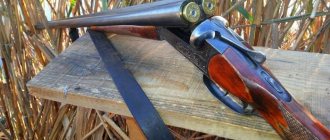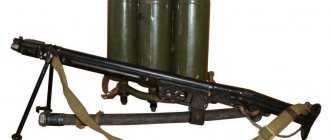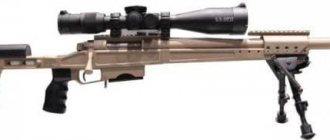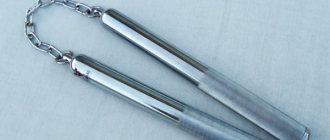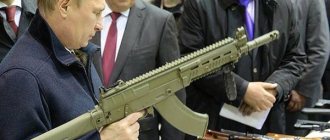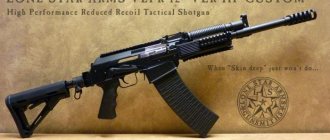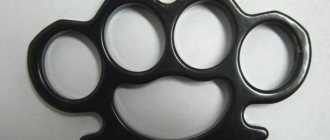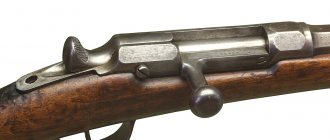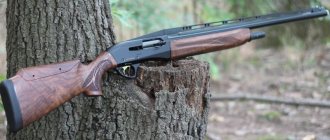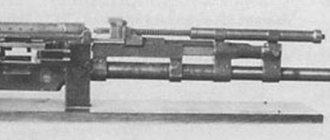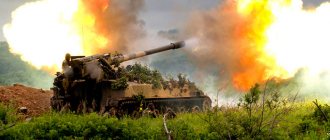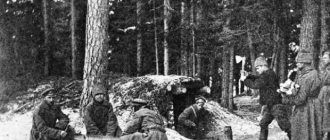Firearms by the beginning of the 18th century
Firearms by the beginning of the 18th century
All of these changes became almost universal only by the beginning of the 18th century. By this time, a model of a gun that was quite satisfactory for that time for arming all infantry had finally been developed.
The information below shows how, over the course of four centuries, various improvements were gradually introduced into the design of the gun, depending on technological advances.
XIV century - the appearance of the initial samples of handguns.
15th century - adoption of the matchlock.
15th century - replacement of a straight stock with a curved one.
16th century - appearance of wheel locks.
16th century - introduction of muskets.
XVI century - the appearance of rifled weapons with a tightly driven bullet into the bore.
16th century - appearance of flintlocks.
17th century - adopted paper cartridge.
17th century - the appearance of lightweight muskets.
17th century - invention of the bayonet.
17th century - replacement of the wooden ramrod with an iron one.
18th century - widespread adoption of smooth-bore flintlock weapons loaded from the muzzle and partially rifled weapons with the bullet tightly driven into the bore.
In the 18th century, handguns were already so improved that they began to pay special attention to improving their ballistic qualities. The word ballistics means the science of shooting and comes from the Greek word “ballo”, which means: throw.
Ballistic qualities include: a) flatness or flatness of the trajectory, i.e., the path that the bullet takes during its flight in the air, b) range, c) accuracy and d) impact action of the bullet.
A sloping trajectory is one that rises less above the aiming line, that is, above an imaginary line passing from the shooter’s eye through the sight slot and the front sight to the target.
In Fig. 32 shows two trajectories: one, the lower one, is sloping, the other, the upper one, is steep.
Rice. 32. Sloping and steep trajectories.
To hit a target, a flatter trajectory is of great importance, since with such a trajectory the targets will be more likely to be hit.
Let's say that we are shooting at a target ab
(Fig. 33), and in the first case the trajectory will be sloping.
Rice. 33. The affected space with a sloping trajectory.
It can be seen from the figure that wherever the target is placed between the shooter and the point of impact of the bullet, it will be hit everywhere. In the case of a steeper trajectory (Fig. 34), the target will be hit only in a small area of the air
at the end of the trajectory.
Rice. 34. The affected area with a steep trajectory.
Av distance
called the target space.
The greater the slope of the trajectory, the larger the area the targets will be hit, the larger the affected spaces will be.
If the trajectory does not rise above a given target, then such a shot is called direct; the resulting range is called the direct shot range. For 7.62 mm rifle mod. 1891, a direct shot was a shot with a constant sight of 4, which corresponded to a range of 400 steps for a blunt bullet. The trajectory of such a shot did not rise above 45 cm. When shooting with a sight corresponding to the range of a direct shot, no matter where the target was, it would be hit everywhere within the specified range. There is no need to move the sight at all intermediate distances.
Range is necessary to be able to hit the enemy from longer distances.
Accuracy is important to increase the possibility of hitting the target.
The impact action of bullets should be sufficient to incapacitate living targets at all distances of firing from a weapon (lethal ability), as well as to penetrate various covers: parapets, wooden shelters, armor shields, armor of armored vehicles and tanks (penetrating ability).
A century and a half in service: what were the Russian archers armed with?
In 1550, Tsar Ivan IV the Terrible, by his order, established a new structure - the Streltsy army. Instead of squeaker militias, for the first time in Russian history, a regular army was created, called upon to fight with bladed weapons and firearms. Over the next century and a half, the archers became the most important component of the army. To solve combat missions, the archers relied on a developed set of weapons, which were improved as their service continued.
Fire fight
The main task of the Streltsy, like their predecessors the Pishchalniks, was to fire at enemy troops. To solve this problem, at different times the Streltsy army was armed with squeaks and muskets of different classes and types. Based on available historical sources and archaeological finds, one can observe the processes of development of small arms of the army.
Streltsy of Moscow regiments, end of the 17th century. Illustration from “Historical description of clothing and weapons of Russian troops” by A.V. Viskovatova
From their predecessors, the archers received hand-held arquebuses. It was a smooth-bore muzzle-loading weapon with a matchlock or a jagra. The early squeaks of the Russian archers were similar in design to the European arquebuses of their time. It was the arquebus that was the main weapon of the archer. During the battle, the warriors had to hit the enemy with massive fire. Other weapons were considered auxiliary.
Firearms of Streltsy. Illustration from “Historical description of clothing and weapons of Russian troops” by A.V. Viskovatova
The arquebus was supplied with the equipment necessary to transport the ammunition. Over his left shoulder, the archer wore a berendeik sling, on which hung sockets for gunpowder and bullets, as well as a powder flask. All these devices made it possible to obtain an acceptable rate of fire from not the most advanced muzzle-loading squeaks.
According to the regulations, the archers received gunpowder and bullets immediately before the campaign. The remaining ammunition had to be handed over after returning, which allowed the state to save on the maintenance of troops.
For a long time, matchlocks remained the main weapon of the archers. However, at the beginning of the 17th century. they have the first flintlock guns. The mass introduction of such weapons has been noticeably delayed. It is believed that this was due to the complexity and high cost of the guns, as well as difficulties at the stage of launching its own production. As a result, both imported and domestic guns from different manufacturers with different designs and characteristics were in service.
Nevertheless, the rearmament was launched and carried out. Already by the middle of the 17th century. The documents record not only the need to purchase gunpowder and lead, but also the requirements for the supply of flints for guns. However, the decommissioning of obsolete matchlocks has been noticeably delayed. Such weapons remained with the archers almost until the end of the 17th century.
Berendeyka with nests and powder flask. Illustration from “Antiquities of the Russian State”, F.G. Solntsev
In the second half of the century, a new modernization of firearms began. Abroad and in our country, “screw-mounted squeaks”—rifled weapons—began to become widespread. Approximately in the seventies, such systems began to enter the Streltsy army and gradually its share grew. However, the rifled systems were highly complex and expensive, which is why the pace of rearmament was again slow. For a long time, smooth-bore guns remained the basis of the archers' weapons complex.
It is curious that the replacement and modernization of the main weapons had almost no effect on the composition of the equipment. The berendeika with nests and powder flask were preserved and continued to perform their functions. This was facilitated by the preservation of some basic principles of operation of standard weapons.
The introduction of rifled weapons was the last step in the modernization of the Streltsy’s “fire combat” means. Such systems, together with auxiliary weapons, were used for several decades - until the disbandment of the Streltsy regiments. Then they moved on to new armed formations of the Russian army.
Cold and polearm
The main task of the archers was to defeat the enemy by fire. However, they retained edged weapons and polearms - mainly for self-defense in situations where the use of arquebuses was impossible or difficult. In general, the edged weapons of the Streltsy army repeated the complex of infantry weapons of that time.
The archer fires from a arquebus, leaning on the reed. Illustration from “Small Arms” by A.B. Beetle
On his left side, on his belt, the archer wore a sheath with a saber or sword. Streltsy received the same bladed weapons as other Russian warriors. During the existence of the Streltsy army, various designs of sabers and swords with certain features were in service. In all cases, such weapons were intended for combat with an approaching enemy. Due to the specific nature of the combat work of the archers, it was often a matter of self-defense.
From the infantry, the archers received a berdysh - a special type of battle ax with an elongated blade and a long shaft. Berdysh performed two main functions. In close combat it should have been used in the normal manner as a slashing weapon. When firing, it became a bipod for a weapon: the squeak stock was placed on the butt, which simplified aiming and shooting.
During the 17th century. There was some change in the range of weapons associated with the peculiarities of the work of archers of different specialties. Thus, commanders eventually lost firearms, the use of which could be difficult. Their weapons consisted only of a saber and a protazan - a long spear with a special tip. Standard bearers and musicians had only sabers for self-defense.
Sabers of the Russian army, incl. Streltsov. Illustration from “Historical description of clothing and weapons of Russian troops” by A.V. Viskovatova
At the beginning of the 17th century. The first units of pikemen appear in the Streltsy army. These fighters were armed with long pikes and swords. Their weapons were intended to strengthen the defense of the Streltsy unit and effectively protect against the characteristic threats of that time.
Explosive innovation
At the beginning of the 17th century.
In the records, for the first time, a fundamentally new weapon for archers is found - hand grenade cores. These were compact and relatively lightweight cast ammunition filled with powder and a simple wick fuse. They had to be thrown in the direction of the enemy manually, which limited the range of use. However, the damaging effect compensated for all the shortcomings. Hand grenade cores received limited distribution, but were still produced and distributed among the Streltsy orders. At different times and in different regiments, hundreds of units of such weapons were in storage, and they were used if necessary.
Evolution of weapons
The Streltsy army was formed in the middle of the 16th century.
and existed until the beginning of the 18th century. For more than a century and a half, this component of the army has come a long way and changed noticeably. First of all, weapons were developed that were directly used to solve combat missions. Uniforms, weapons and equipment of the archer in the State Historical Museum. Photo: Wikimedia
It is easy to see that the evolution of the Streltsy weapons was based on the most modern ideas and solutions. It was not always possible to introduce modern models on time and in the desired quantities, but the trend towards the development of troops can be seen quite clearly. In updating the material part, the Streltsy army actively used both domestic and foreign ideas and samples.
This approach made it possible to maintain a high combat capability of the army, but had characteristic disadvantages. First of all, there was no unification of weapons and ammunition, which led to certain problems. The first measures aimed at establishing uniformity date back only to the second half of the 17th century, but the real effect in this direction was achieved even later.
At the beginning of the 18th century. The Streltsy army was liquidated and replaced by new types of regiments. However, the archers' weapons complex and some of their equipment remained in service. With certain changes, guns and muskets, reeds and sabers became part of the armament of the modernized troops, where they were soon supplemented by completely new models.
